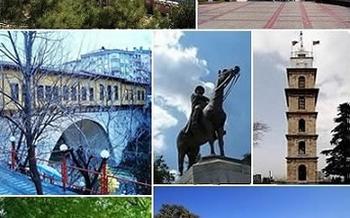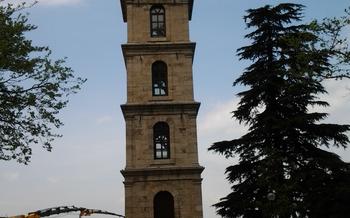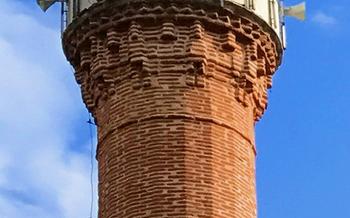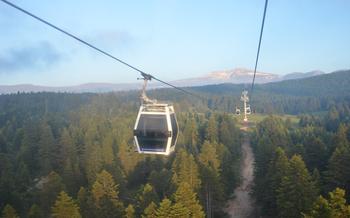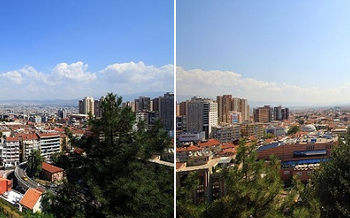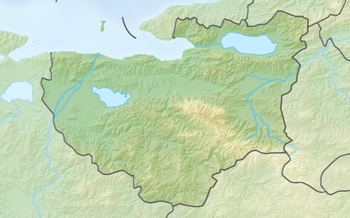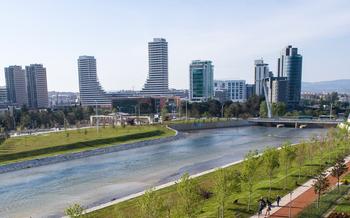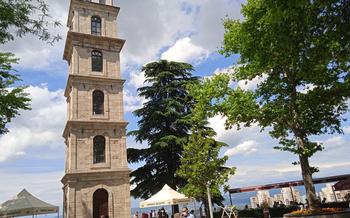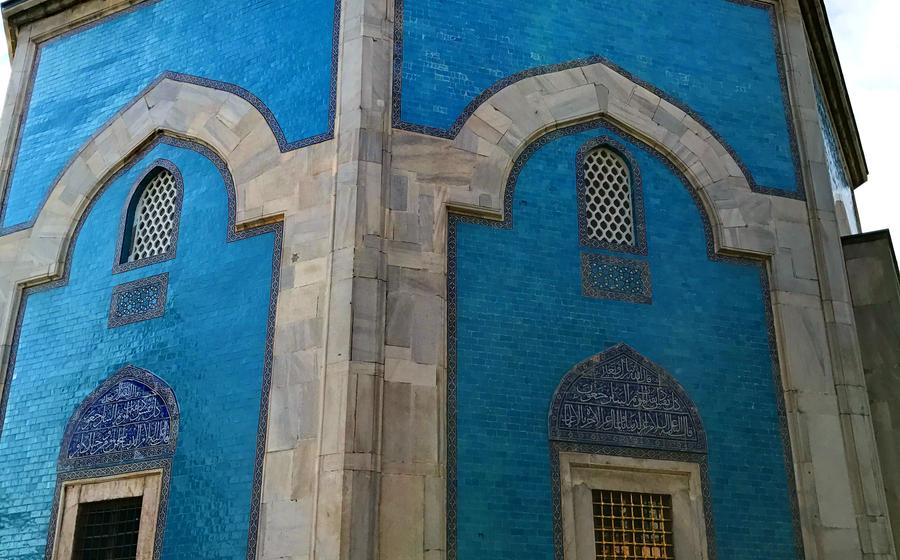
Green Tomb (Yeşil Türbe)
- The Green Tomb: An Overview
- Historical Context
- Calligraphy and Inscriptions
- Anecdote:
- Symbolism and Iconography
- Mehmed I's Legacy
- Bursa's Significance
- Visiting the Green Tomb
- Nearby Attractions
- The Green Tomb in Turkish Culture: A Symbol of Respect and Pilgrimage
- Preservation and Conservation
- Souvenirs and Shopping
- Photography Tips
- Insider Tip: A Hidden Gem and the Best Time to Visit
The Green Tomb: An Overview
The Green Tomb, or Yeşil Türbe, is an architectural masterpiece and a symbol of Ottoman power and wealth. Built in the early 15th century by Sultan Mehmed I, the tomb is located in the city of Bursa, Turkey, the first capital of the Ottoman Empire. Its octagonal design, intricate tilework, and beautiful interior make it a must-see for anyone interested in Islamic art and architecture.
The Green Tomb is not only a historical landmark but also a place of pilgrimage and reverence. Visitors come from all over the world to pay their respects to Sultan Mehmed I and to marvel at the beauty of the tomb. The tomb's unique architecture and rich symbolism have made it one of the most iconic landmarks in Turkey.
My first visit to the Green Tomb was a profound experience. As I stepped inside, I was struck by the beauty and serenity of the space. The intricate tilework and the soft light filtering through the windows created a magical atmosphere. I spent hours exploring the tomb, admiring the details of the architecture and the calligraphy, and learning about the history of the Ottoman Empire.
The Green Tomb is a reminder of the rich history and cultural heritage of Turkey. It is a place where history, art, and religion come together to create a truly special experience.
Historical Context
During the reign of Sultan Mehmed I, the Ottoman Empire underwent a period of significant expansion and consolidation. Mehmed I ascended to the throne in 1413 and quickly proved to be a capable and ambitious ruler. Under his leadership, the Ottomans conquered new territories in the Balkans and Anatolia, extending the empire's reach and influence.
Bursa, the first capital of the Ottoman Empire, played a crucial role in Mehmed I's reign. The city served as the administrative and political center of the empire, and Mehmed I made significant contributions to its development and beautification. He commissioned the construction of numerous mosques, palaces, and other buildings, transforming Bursa into a thriving and prosperous city.
The Green Tomb, built in 1421, stands as a testament to Mehmed I's power and wealth. The tomb's intricate tilework, calligraphy, and architectural features reflect the grandeur of the Ottoman Empire during this period. It serves as a symbol of Mehmed I's achievements and his lasting legacy as a ruler who laid the foundation for the empire's future success.
Anecdote:
During my visit to the Green Tomb, I couldn't help but be struck by the story of a legendary figure associated with the tomb. According to local lore, a holy man named Sheikh Edebali played a significant role in Mehmed I's rise to power. Edebali is said to have given Mehmed I his blessing and guidance, which helped the young prince to overcome his rivals and secure the throne. The tale of Sheikh Edebali's influence serves as a reminder of the deep cultural and spiritual roots of the Ottoman Empire and the importance of seeking divine favor in times of political turmoil.
Calligraphy and Inscriptions
The Green Tomb is not just an architectural marvel but also a testament to the exquisite craftsmanship of Islamic calligraphy. The interior and exterior walls are adorned with stunning Arabic and Persian inscriptions, adding a layer of spiritual and historical significance to the structure. Verses from the Quran, poems praising Sultan Mehmed I, and historical accounts are meticulously inscribed on the tiles, creating a symphony of words that resonate with faith and devotion.
The calligraphy, executed by master calligraphers of the time, demonstrates the high level of artistry and precision that characterized Islamic art. The intricate lines, graceful curves, and harmonious composition of the inscriptions not only enhance the aesthetic appeal of the tomb but also convey profound messages and historical narratives.
In the Islamic tradition, calligraphy holds a revered position, seen as a sacred art form that transcends mere writing. The calligraphers who worked on the Green Tomb were not just artisans but also scholars and theologians, imbuing their work with spiritual and intellectual depth.
Anecdote:
As I stood before the intricately inscribed walls of the Green Tomb, I couldn't help but be captivated by the beauty and craftsmanship of the calligraphy. One particular inscription, written in elegant Arabic script, caught my eye. It was a verse from the Quran that spoke of the transience of life and the inevitability of death.
Reading that verse, I was reminded of the mortality of all things, including the grand structures and empires that humans build. The Green Tomb, despite its grandeur and splendor, would one day succumb to the ravages of time. Yet, the words inscribed on its walls would endure, carrying the messages of faith and history for generations to come.
Symbolism and Iconography
The Green Tomb is not just a masterpiece of architecture but also a repository of profound symbolism and iconography. The tomb's octagonal shape represents the number eight, which is considered auspicious in Islamic culture and symbolizes eternity and perfection. The cypress trees depicted on the tiles symbolize life and immortality, while the tulips represent heavenly gardens and paradise. The colors used in the tilework also carry symbolic meanings: green represents nature and fertility, blue represents the sky and spirituality, and red represents passion and love.
One particularly striking symbol in the tomb is the double-headed eagle, which appears on the tomb's entrance gate. The double-headed eagle is a powerful symbol that has been used by various empires throughout history. In the context of the Green Tomb, it represents the Ottoman Empire's strength, power, and dominion over both East and West.
Anecdote:
As I stood before the Green Tomb, I couldn't help but be drawn to the intricate tilework adorning its exterior. The vibrant colors and intricate patterns seemed to dance before my eyes, inviting me to decipher their hidden meanings. I spent hours poring over the tiles, discovering new symbols and motifs with each passing moment. The experience was both awe-inspiring and enlightening, as if I were unlocking a secret code to a lost world.
Mehmed I's Legacy
Sultan Mehmed I's reign marked a pivotal era in the history of the Ottoman Empire. His accomplishments and contributions left an indelible mark on the empire's trajectory, shaping its future course and establishing its foundations as a formidable power.
Under Mehmed I's leadership, the Ottoman Empire embarked on a path of expansion and consolidation. His military prowess and strategic acumen led to the conquest of new territories, extending the empire's reach and influence across the region. Through his diplomatic skills and alliances, he fostered stability and maintained peaceful relations with neighboring states, ensuring the empire's security.
Mehmed I's patronage of the arts and architecture played a crucial role in shaping the cultural landscape of the Ottoman Empire. His passion for aesthetics and his appreciation for the finer things in life led to the construction of magnificent buildings, mosques, and palaces, including the iconic Green Tomb. These architectural masterpieces not only showcased the empire's wealth and power but also served as symbols of its cultural and artistic achievements.
Mehmed I's legacy extended beyond his reign. His vision and leadership laid the groundwork for the empire's future growth and success. His contributions to the arts, architecture, and governance left a lasting impact on the Ottoman Empire, ensuring its place as a major player on the world stage.
Anecdote:
In the heart of Bursa, an elderly storyteller captivated a group of listeners with tales of Mehmed I's generosity. He spoke of a time when the sultan, disguised as a commoner, roamed the streets, seeking those in need. One evening, he stumbled upon a family struggling to make ends meet. Touched by their plight, Mehmed I discreetly left a pouch of gold at their doorstep, transforming their lives and inspiring countless acts of kindness throughout the empire.
Bursa's Significance
Bursa holds a significant place in Turkish history and culture, having served as the first capital of the Ottoman Empire from 1326 to 14During this period, the city flourished as a center of trade, art, and architecture, laying the foundation for the empire's future expansion.
Bursa's rich cultural heritage is reflected in its diverse population and numerous historical landmarks. The city is home to several well-preserved Ottoman-era mosques, madrasahs, and caravanserais, each showcasing unique architectural styles and decorative elements. Bursa is also renowned for its vibrant silk and textile industry, which has been passed down through generations of skilled artisans.
In addition to the Green Tomb, visitors to Bursa can explore other notable attractions, such as the Ulu Mosque, one of the oldest and most significant mosques in Turkey, and the Bursa Silk Market, a bustling bazaar where you can find a wide variety of textiles and handicrafts. The city also offers stunning natural scenery, with Mount Uludağ, a popular destination for skiing and hiking, just a short distance away.
Anecdote:
During my visit to Bursa, I had the opportunity to witness the city's vibrant cultural scene firsthand. I stumbled upon a traditional Turkish wedding ceremony taking place in one of the old mosques, with guests dressed in colorful attire and traditional music filling the air. It was a truly memorable experience that gave me a glimpse into the rich cultural traditions of Bursa.
Visiting the Green Tomb
Visiting the Green Tomb is an enriching and awe-inspiring experience that offers a glimpse into Ottoman history, architecture, and art. Here are some practical tips to make the most of your visit:
-
Visiting Hours: The Green Tomb is open to the public daily during regular hours. Confirm the specific hours before your visit to avoid any inconvenience.
-
Admission Fees: The entrance to the Green Tomb is free of charge, allowing visitors to appreciate its beauty and significance without any financial barriers.
-
Accessibility: The tomb is easily accessible, with a convenient location within the city center. It is within walking distance from other notable landmarks, making it easy to combine a visit with a broader exploration of Bursa.
-
Guided Tours: For a deeper understanding of the tomb's history and features, consider joining a guided tour. Knowledgeable guides provide insights into the architectural details, symbolism, and historical context of the monument.
-
Photo Opportunities: The Green Tomb offers ample photo opportunities for capturing its intricate tilework, calligraphy, and overall grandeur. Take advantage of the natural light to capture vibrant shots of the exterior and interior.
-
What to Look For: When visiting the tomb, pay attention to the exquisite tilework adorning the exterior, which showcases a blend of geometric and floral patterns. Inside, admire the calligraphy that adorns the walls and the intricate mihrab, a niche indicating the direction of Mecca.
-
What to Expect: Be prepared for a serene and contemplative atmosphere within the tomb. Visitors are encouraged to maintain a respectful demeanor in keeping with the sacred nature of the site.
-
Anecdote: During my visit, I was particularly struck by the intricate tilework on the tomb's exterior. The vibrant blues and greens seemed to dance in the sunlight, creating a mesmerizing effect. It was a reminder of the skill and artistry of the craftsmen who created this masterpiece centuries ago.
Nearby Attractions
In addition to the Green Tomb, Bursa offers a wealth of historical and cultural attractions. Just a short walk away, you'll find the Grand Mosque of Bursa, a stunning example of Ottoman architecture with its towering dome and intricate tilework. History buffs can delve deeper into the city's past at the Bursa Archaeological Museum, which houses a rich collection of artifacts from the region's ancient civilizations.
For a taste of Bursa's vibrant modern culture, head to the bustling bazaar district. Here, you can haggle for traditional Turkish handicrafts, sample delicious street food, and soak up the lively atmosphere. Don't miss the Koza Han, a historic silk market that has been beautifully restored and now houses shops, cafes, and art galleries.
If you have time, take a scenic cable car ride up to Uludağ, a mountain resort that offers breathtaking views of the city and surrounding countryside. In the winter, Uludağ transforms into a popular ski destination, while in the summer, it's a great place to hike, bike, and enjoy the fresh mountain air.
Anecdote:
During my visit to Bursa, I stumbled upon a hidden gem tucked away in a quiet corner of the city. As I wandered through the narrow streets, I noticed a small, unassuming doorway. Curiosity got the best of me, so I stepped inside and found myself in a beautiful courtyard filled with lush greenery and colorful flowers. In the center of the courtyard stood a small mosque with a delicate minaret.
As I explored further, I learned that this hidden mosque was called the Emir Sultan Mosque, named after a revered Sufi saint. The mosque was built in the 14th century and is considered one of the oldest and most sacred mosques in Bursa. The interior of the mosque was adorned with intricate tilework, calligraphy, and stained-glass windows that created an atmosphere of serenity and devotion.
I spent a peaceful hour exploring the Emir Sultan Mosque, marveling at its beauty and learning about its history. It was a truly special experience that reminded me of the many hidden treasures that Bursa has to offer to those who take the time to explore.
The Green Tomb in Turkish Culture: A Symbol of Respect and Pilgrimage
In Turkish culture, the Green Tomb holds a profound significance beyond its historical and architectural value. It serves as a sacred pilgrimage site, drawing countless visitors seeking spiritual connection and paying homage to Sultan Mehmed I, a revered figure in Ottoman history. The tomb is a tangible representation of Turkish heritage and a symbol of respect for the country's rich Islamic traditions.
Local customs and rituals surrounding the Green Tomb reflect the deep reverence in which it is held. Visitors often remove their shoes before entering the mausoleum as a sign of respect for the deceased. They may also recite prayers or leave offerings, such as flowers or coins, as gestures of devotion. The tomb's serene atmosphere invites contemplation and reflection, encouraging visitors to connect with the spiritual legacy of the Ottoman Empire.
The Green Tomb's enduring significance extends beyond its religious and historical importance. It stands as a symbol of cultural continuity, bridging the past with the present. By preserving and honoring this architectural masterpiece, Turkey celebrates its rich heritage and reinforces the importance of tradition and cultural identity in a rapidly evolving world.
Preservation and Conservation
The Green Tomb has undergone several restoration and conservation projects over the years to ensure its preservation as a historical monument. These efforts have focused on maintaining the structural integrity of the building, restoring the intricate tilework and decorative elements, and protecting the interior from wear and tear.
One of the challenges in preserving the tomb is balancing conservation with accessibility and tourism. The tomb is a popular tourist destination, and the increased foot traffic can put a strain on the structure. To address this, the authorities have implemented measures such as limiting the number of visitors allowed inside the tomb at a time and providing guided tours that emphasize the importance of respecting the historical significance of the site.
The preservation of the Green Tomb is crucial for protecting and preserving Turkey's cultural heritage for future generations. By maintaining this magnificent monument, we ensure that future visitors can continue to appreciate its beauty, history, and cultural significance.
Anecdote:
During my visit to the Green Tomb, I had the opportunity to speak with one of the conservators working on the restoration project. He explained that the intricate tilework on the exterior of the tomb required meticulous care and attention to detail. Each tile had to be carefully removed, cleaned, and replaced to ensure that the original design and colors were preserved. It was fascinating to learn about the dedication and expertise required to maintain this historical treasure.
Souvenirs and Shopping
When visiting the Green Tomb, you'll find a variety of unique souvenirs and handicrafts to commemorate your trip. The nearby markets offer a treasure trove of traditional Turkish items, from intricate carpets and textiles to hand-painted ceramics and copperware. Bargaining is expected, so don't be afraid to haggle for the best price.
One of the most popular souvenirs is a miniature replica of the Green Tomb, a beautiful keepsake that will remind you of your visit. You can also find a variety of other items inspired by the tomb's architecture and design, such as jewelry, scarves, and decorative tiles.
Bursa is also known for its delicious cuisine, so be sure to sample some of the local specialties. The city's markets are a great place to find fresh produce, spices, and sweets. You can also find a variety of restaurants and cafes serving traditional Turkish dishes, such as kebabs, pide, and börek.
Anecdote:
During my visit to Bursa, I stumbled upon a small shop tucked away in a side street near the Green Tomb. The shop was filled with beautiful handmade ceramics, each one unique and intricately painted. I couldn't resist buying a small bowl with a vibrant blue design that reminded me of the tiles on the tomb's exterior. It's now a cherished souvenir that I display prominently in my home, and it always brings back fond memories of my trip to Bursa.
Photography Tips
Capturing the beauty of the Green Tomb through photography is a rewarding experience. Here are some tips to help you take stunning shots:
-
Utilize Natural Light: The tomb's exterior shines under the warm glow of the sun. Plan your visit during the golden hours (sunrise and sunset) to take advantage of the soft, diffused light that enhances the colors of the tiles.
-
Compose Your Shots: Pay attention to the composition of your photos. Experiment with different angles and perspectives to create visually interesting images. Incorporate elements like the surrounding greenery or the tomb's reflection in a nearby water body for a unique touch.
-
Focus on Details: The Green Tomb is adorned with intricate tilework, calligraphy, and decorative elements. Take your time to capture close-up shots of these details to showcase the craftsmanship and artistry that went into its creation.
-
Experiment with Different Lenses: If you have a DSLR or mirrorless camera, consider using different lenses to achieve various effects. A wide-angle lens can capture the tomb's grandeur, while a telephoto lens can isolate specific details or create a sense of depth.
Anecdote:
During my visit to the Green Tomb, I spent a considerable amount of time experimenting with different camera settings and angles. As the sun began to set, I noticed how the warm light illuminated the tiles, casting an ethereal glow on the tomb's exterior. I captured a striking image of the tomb against the backdrop of the golden sky, which remains one of my favorite photographs from my travels.
Insider Tip: A Hidden Gem and the Best Time to Visit
For a truly unique experience, venture behind the Green Tomb to discover a hidden gem – a small, serene garden that offers a tranquil escape from the bustling city. Amidst lush greenery and colorful flowers, you'll find a secluded fountain, a perfect spot to sit, reflect, and soak in the peaceful ambiance.
To fully appreciate the Green Tomb's beauty and avoid the crowds, plan your visit for early morning or late afternoon, when the light is at its most flattering. The soft, golden hues of sunrise and sunset illuminate the intricate tilework and calligraphy, creating a magical atmosphere that will leave you spellbound.

